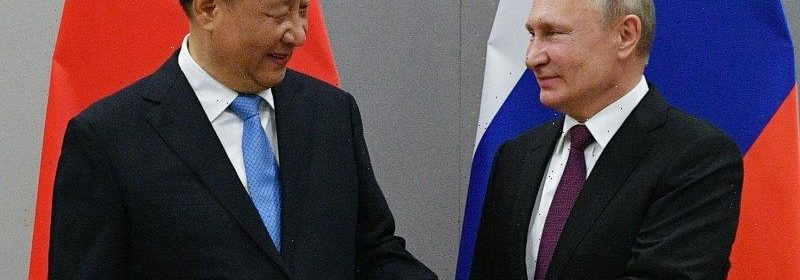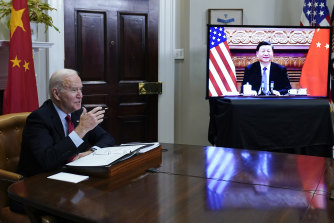The Quad’s crucial ‘China strategy’ a necessity for peace

China’s competing economic influence and re-emerging power will be high on the agenda when the four Quadrilateral Security Dialogue foreign ministers – from Australia, the United States, India and Japan –meet in Melbourne on Friday to discuss the search for stability and security of the Indo-Pacific region.
Each member country has its own unique tensions and complicated relationship with the superpower. And it has been suggested the escalating conflict between Russia and Ukraine has the possibility to be used as a template for China’s ongoing crisis with Taiwan.
The Quad has never been explicit in its language on China. It has not even mentioned the country’s name in communiques. However, what makes the renewed Quad so significant is its role as a democratic counterweight to an authoritarian China in the Indo-Pacific.
US President Joe Biden during a virtual meeting with Chinese President Xi Jinping. Washington often talks about collaboration and engagement with China.Credit:AP
All four countries have found common ground among their shared fixation on China’s assertive behaviour in the region.
For India, ongoing skirmishes on its Himalayan border with China continue to threaten Indian sovereignty, despite more than a dozen rounds of military and diplomatic talks between Delhi and Beijing.
For Australia, its decision to exclude Huawei from its 5G rollout and its call for an inquiry into the COVID-19 pandemic has been met with a strong China diplomatic backlash. India similarly disallowed Chinese state-owned companies from investing in infrastructure projects, and kept Huawei out of its 5G infrastructure.
This shared position on China between Australia and India has been referred to a sort of “kinship” between both democracies. That kinship bodes well for Australia’s efforts by its current Trade Minister Dan Tehan to reach some sort of early trade agreement before the election.
For Japan, China’s assertions of its sovereignty in both the South China Sea and East China Sea through military build-ups and the building of artificial islands have long sounded alarm bells in Tokyo.
As for the United States, a superpower that has provided stability and centrality to the current order, it now faces challenges that need a different response to the changing dynamics in the region, particularly responding to a country whose military and economic growth threatens Washington’s influence, power and status on the global stage.
The evolving crisis between Russia and Ukraine will no doubt be canvassed at the Quad’s Melbourne meeting, but whether it will be discussed in terms of a potential blueprint of the strategic challenge of China with Taiwan remains to be seen. Beijing is no doubt closely watching the escalating situation for its interests in Taiwan.
In recent years, the People’s Republic of China (PRC) has intensified its efforts to unite Taiwan with the mainland of China, through manoeuvring naval vessels towards the Taiwan Strait median line and sending incursions of warplanes into Taiwan’s defence zone.
Established in 1954 by the United States, the Taiwan Strait median line has aimed to maintain peace and safety in the Western Pacific. However, China’s shifting attitude has been highlighted by its provocative actions, breaching the median line more than 877 times over the course of 2021 through its incursions into Taiwan’s Air Defence Identification Zone.
Interestingly, US support for Taiwan among members of Congress has steadily increased since Russia’s annexation of Crimea in 2014. The analogy between Russia/Ukraine and China/Taiwan is therefore not ill-founded. Considering there is Congress support for Taiwan in the face of China’s aggression, the US is in a strong position to raise the Ukraine analogy with Quad members.
The Quad should consider its options in the Indo-Pacific in response to increasing Chinese assertiveness vis à vis Taiwan. Abandonment of Taiwan would not only leave it extremely vulnerable to occupation, but also lead other Asian allies to question US security in the region. However, an immediate mobilisation of US military assets could be counter-productive to building peace and stability in the region.
The Quad could instead focus on a shared “middle ground” approach, characterised by incremental strategic action through diplomacy and deterrence, by communicating with Beijing, issuing joint statements with regional allies and enforcing sanctions. This also has the potential to pave the way for a new Quad-plus dialogue.
If the Quad addresses China’s interests in Taiwan through a security pact, this would not only provide Taipei with the reassurance of stability, but would also signal to other allies in the region that these democratic forces are resolute on a rules-based order.
Considering the recent pact of Russia and China to collaborate against the West, deliberating on a “China strategy″ at this Quad meeting remains crucial to maintaining peace, regional stability and a rules-based order both within the Indo-Pacific and outside of it.
Lisa Singh is chief executive of the University of Melbourne’s Australia India Institute, deputy chair of the Australia-India Council, former Labor senator for Tasmania 2011-19 and the first woman of Indian heritage to be elected to federal Parliament. Ms Singh will host India’s External Foreign Affairs Minister Hon. Dr. S. Subrahmanyam Jaishankar at an event on Friday.
The Morning Edition newsletter is our guide to the day’s most important and interesting stories, analysis and insights. Sign up here.
Most Viewed in National
From our partners
Source: Read Full Article

